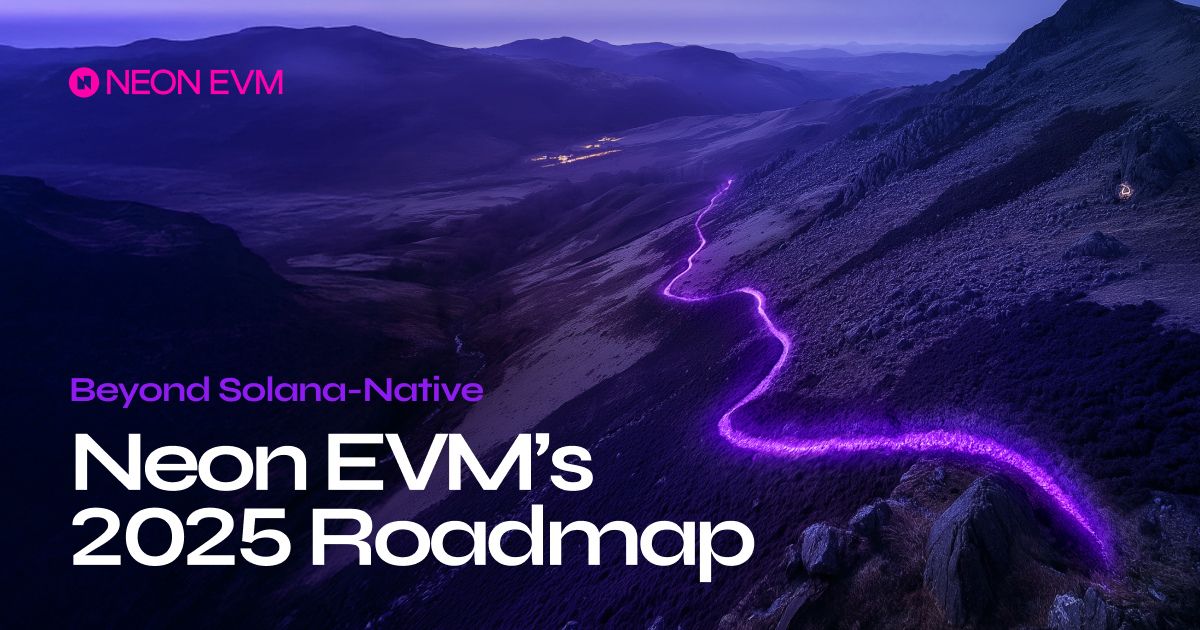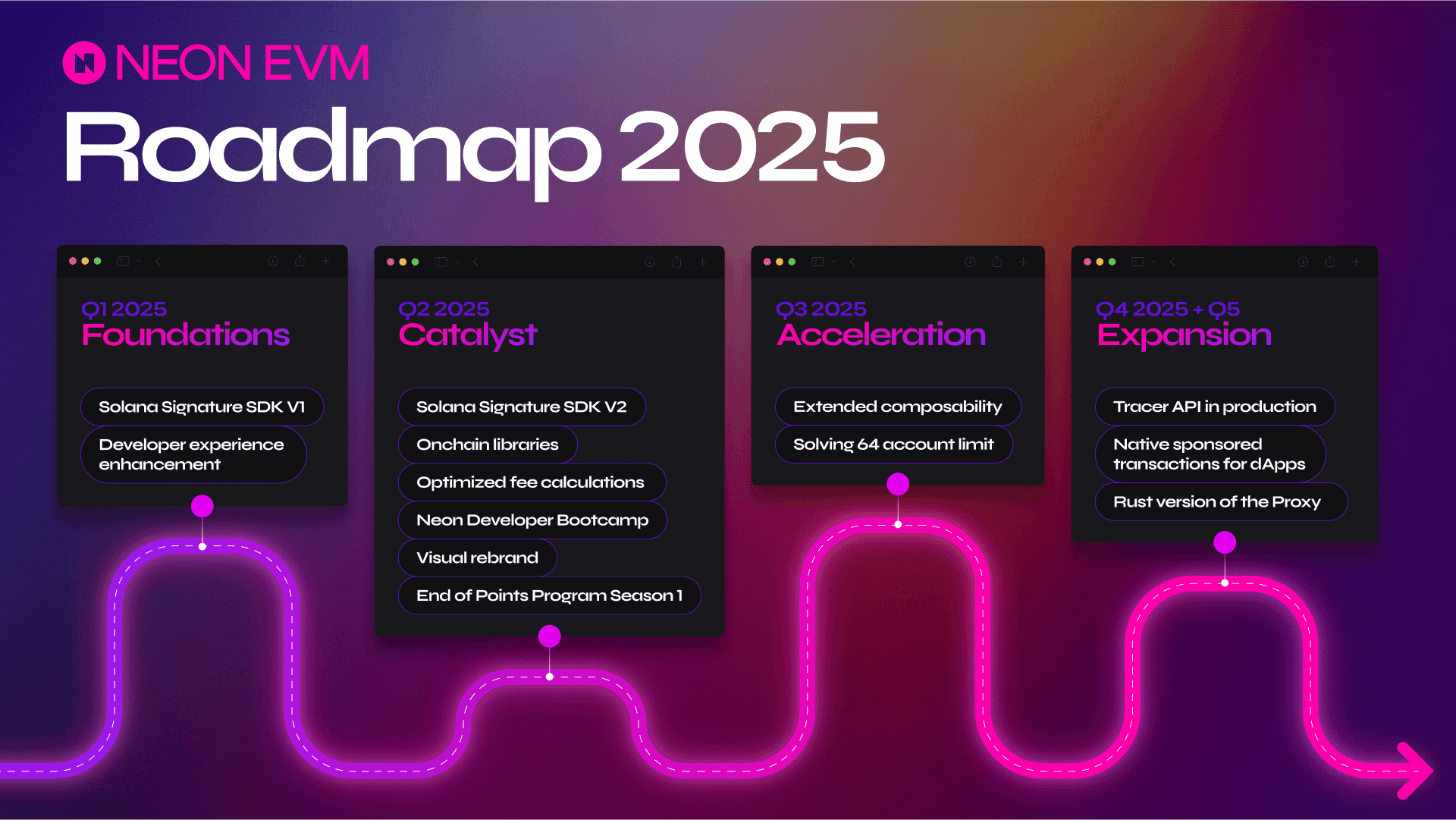Beyond the Solana-Native Approach: Neon EVM's Updated Roadmap

Four years ago, we set out with a vision: to bring Ethereum’s vast ecosystem to Solana’s high-performance blockchain. We believed in a world where developers shouldn’t have to choose between familiarity with EVM development tooling and Solana's performance. And we bet hard on Solana becoming the everything chain.
Today, that vision is no longer just an idea; it’s a thriving reality.
Throughout the years, we built, tested, and deployed the unique EVM layer on Solana, unblocked true parallel execution to become the first parallelized EVM ever - powered by $NEON - and introduced the Solana network extension concept. We then rolled out our Solana-native experience, designing the developer experience around the SDK, allowing EVM dApps to be accessible by Solana audience.
In the meantime, Solana became the backbone of the new financial system. It now hosts a multi-billion market, has the fastest-growing developer ecosystem, and has surpassed Ethereum on most major on-chain metrics.
Our bet on Solana holds strong for the future
By scaling Solana beyond public internet latency bottlenecks via DoubleZero, and the combination of Anza’s mission and Firedancer development to reach 1m TPS, the goal is clear: Increase Bandwidth Reduce Latency (IBRL) to make Solana the actual competitor of TradFi markets.
Naturally, even without waiting for all these innovations, EVM dApps are actively looking at Solana as a potential market opportunity.
In a multichain vision, the expansion toward Solana sounds natural, but competition is already there: you can’t just fork a legacy protocol and expect it will work on Solana too, as only higher efficiency is capturing attention.
While it’s possible to have a first-mover advantage in bootstrapped ecosystems and conquer the market regardless of product maturity, the dynamics here are different. Coming to Solana might require an initial higher effort, but addressing a wider and established user base gives more chances to find traction and retention in the long term - as Solana already faced the weakest phase of its history and users demonstrated to be loyal and stick to the ecosystem.
PMF, the key differentiation factor
Everything at Neon EVM moves around testing Product-Market Fit (PMF). It has been our north star since the beginning, and it’s the direction towards success.
We are dedicated to satisfying and adapting to market demand and developers’ needs. How do we do this? Identify. Test. Measure. Analyze. Repeat.
Our mission is to continue abstracting the Solana complexities to builders, smoothing most of the onboarding barriers and builders’ challenges.
We are not stopping here and there is much more we want to achieve: a world where deploying an EVM dApp is truly seamless and as easy as a piece of cake.
This said, today we unveil the updated Neon EVM roadmap for the rest of the year.
Grounded in Solana, propelled by EVM developer adoption: 2025 outlook
Our journey has always been about breaking barriers. With this plan, we are doubling down on accessibility, performance, and PMF. Here’s what’s coming.

Phase 1, Foundations: Driving the Solana-Native Shift (Q1 2025)
Today, Neon is more than just an EVM compatibility layer—it’s a true Solana network extension. In Q1 2025, we’ve advanced our Solana-native approach, launching the Solana Signature SDK and refining the developer journey to set the stage for a seamless user experience.
- Solana Signature SDK V1 - Solana wallets support: Neon EVM now allows EVM dApps to sign transactions with Solana signature and access user’s balance on Solana. Technically speaking, it supports Solana-native ed25519 signatures for Ethereum transactions via on-chain signature verification. EVM dApps deployed on Solana via Neon EVM feel just like native Solana dApps and are accessible via Solana wallets like Phantom, Backpack, and Solflare.
- Developer experience enhancement: Drastic improvement of the developer journey, reducing the steps to jump into documentation and demos, accessing the code to replicate the SDK integration into your dApp so that you can fast-track your dApp to Solana.
Phase 2, Catalyst: Igniting the Builder Ecosystem (Q2 2025)
In the next phase, we’re doubling down on developer adoption and community building. Through enhanced tooling, hands-on training, and tech advancements, we’re making it easier than ever for builders to deploy on Solana via Neon. At the same time, we’re expanding our reach through ecosystem initiatives and a bold new visual identity.
- Solana Signature SDK V2: The second version of the Solana Signature SDK will automate all actions for handling Solana users' balances and reduce code lines and time for developers to integrate EVM apps with Solana wallets. At the same time, the end-user experience remains the same.
- Onchain libraries: Interacting with Solana programs from EVM side, even through our Composability calls is non-trivial, as it requires some hands-on Solana knowledge. In addition, developers interacting with Solana need to be aware of Solana security rules to avoid creating potential vulnerabilities. To reduce the additional burden on application developers, we are building libraries that encapsulate these complexities and offer a simplified, EVM-native interface with Solana's most-used dApps and system programs.
- Optimized fee calculations for lower cost: We combine two distinct ecosystems—Solana and Ethereum—which means our approach to fee calculation needs to accommodate both. Since all Neon transactions ultimately execute on Solana, Neon covers the associated resource costs according to Solana’s rules. However, because our users interact through Ethereum-compatible wallets like MetaMask, we also have to consider Ethereum’s transaction fee logic.
Following our support of Ethereum’s EIP-1559, we’ve adopted Ethereum’s priority fee model. Unfortunately, this model leads to significantly higher transaction costs for users during periods of increased network congestion on Solana, when Solana’s priority fees spike. To address this, we’re refining our fee model to align more closely with Solana’s transaction prioritization system, while preserving compatibility with Ethereum’s priority fee structure for EVM users. This adjustment will notably reduce gas fees and overall transaction costs, particularly under heavy network loads on Solana.
- Neon-branded developer bootcamp: We are launching an educational program to help EVM developers understand Solana better, get to know the Neon EVM tooling and unlock new growth opportunities for their dApps.
- Visual rebrand: In line with the bold new direction of Neon EVM, we will carry out a visual rebrand with an updated Neon logo, a website relaunch and a fresh new look.
- End of Points Program - Season 1: We will wrap up the first season of the Neon Points Program and will announce what is to follow.
Phase 3, Acceleration: Smashing Barriers (Q3 2025)
With key protocol upgrades and improved composability, we continue pushing technical limits to scale Neon to more builders, enriching the Solana ecosystem with new dApps and use cases. The Ambassador Program strengthens our community, accelerating adoption.
- Extended Composability: While Core Composability is limited in the number of EVM instructions (Compute Units to be precise) that you can execute together with calling the Solana programs, in this extended version of composability we will reduce this limitation. Namely, after the implementation of Extended Composability, EVM developers will be able to perform large iterative transactions with Solana programs called in the last iteration.
- Solving 64 account limit: This is the most basic and immovable limit of the Solana itself… And we are going to overcome this for EVM dApps on Solana via Neon by working around these limits! Technically speaking we are going to introduce account containers to store multiple EVM accounts in a single Solana account. We will also optimize and condense account storage especially for often used hash-maps. This allows the compatibility of additional use cases on the DeFi side, such as advanced CLMM and derivatives.
- Neon EVM at ETHCC: We’re coming to Cannes with a series of initiatives focused on branding, product showcase, and developer acquisition. If you pass by, you will find our booth at the main venue.
Phase 4, Expansion: Solana is Global. So is Neon EVM (Q4 2025 + “Q5”)
The focus of this phase will be scaling Neon EVM alongside Solana’s expansion. While our infrastructure keeps improving, our presence at top industry conferences, hackathons, and events reinforces our positioning as the gateway for EVM dApps to tap into Solana’s edge.
- Tracer API in production: Ethereum developers commonly rely on the tracer API (debug_traceTransaction and similar) to effectively debug and analyze transactions. However, Solana currently lacks comparable tooling, primarily because Solana’s state model doesn’t retain historical data, a critical element required for detailed debugging. Furthermore, Solana’s rapid transaction processing and high throughput create vast data sets, significantly complicating the implementation of such features. Recognizing these challenges, the Neon team is proactively developing its own tailored debugging solution, aiming to deliver essential tracing capabilities to both EVM and Solidity developers, thereby bridging this crucial functionality gap between Ethereum and Solana.
- Native sponsored transactions for dApps - applications will be able to natively sponsor user transactions, i.e. put tokens on the balance of smart contracts, which will be used to pay for user transactions automatically.
- R&D and development of Rust version of the Proxy: We will release a more advanced version of our Proxy in order to increase decentralization and offer more Proxy diversity; prepare the Proxy for mass usage by any operator (i.e. simplify managing Proxy at operator side); and improve performance and increase uptime/stability.
- Neon EVM at Devconnect & Solana Breakpoint: Focus on branding, stakeholder and developer relationships, targeting the two most significant industry events of the last quarter of the year.
Many of the Q4 2025 activities will indeed be carried on in 2026, along with supporting activities like regular security audits; growing and nurturing the Neon community; further Neon EVM optimisations: better CU and gas estimations, reducing CU utilization; working with partners and much more.
Join us in shaping the future
Blockchain tech thrives on community. We wouldn’t be here without the developers and visionaries who believe in our mission. As we embark on this next part of the journey, we invite you to be part of it.
We are here to redefine what’s possible for EVM applications on Solana. We are here to bring speed, affordability, and true interoperability to the Web3 world.
The future isn’t something we wait for. It’s something we build together.
Let’s make it happen.
About Neon EVM:
Neon EVM is the first of its kind—a Network Extension on Solana—designed to seamlessly integrate Ethereum Virtual Machine (EVM) compatibility into Solana’s high-performance ecosystem. By operating natively within Solana’s base layer, Neon EVM provides Ethereum developers with a fast, high-throughput pathway to deploy their EVM dApps on Solana, without the need to rewrite their contracts in Rust.
For more information about Neon EVM and future updates, visit neonevm.org and connect with the community on Twitter or Discord.
Disclaimer: Solana is a trademark of the Solana Foundation. The use of the word ‘Solana’ in our materials solely reflects the Neon EVM products’ or services’ compatibility with the Solana network.
From the blog
The latest industry news, interviews, technologies, and resources.